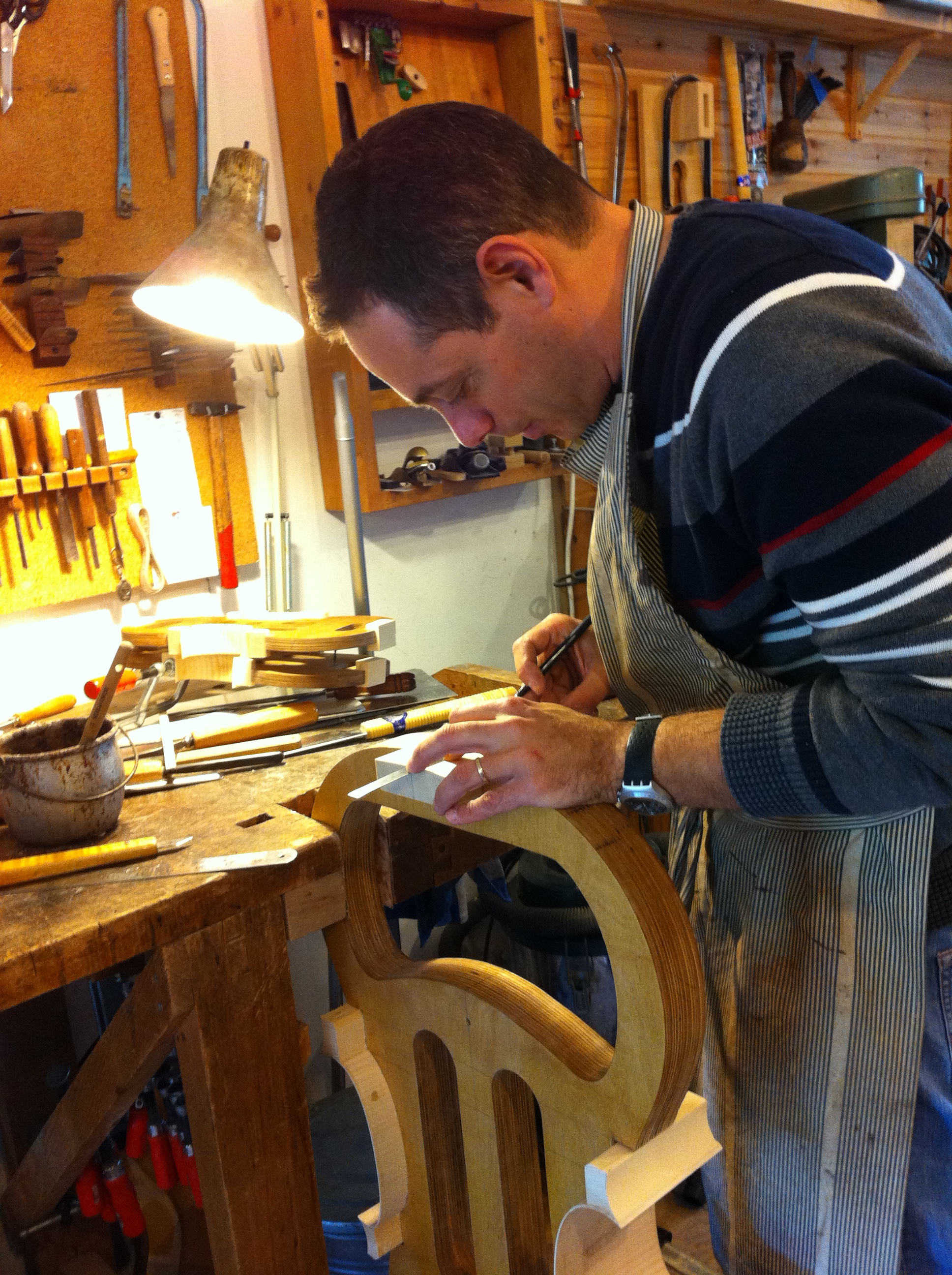
February 2012
Violin Maker's Wife - Two Identical Violins?
February 24, 2012 08:06Post. No. 2
The first step in building a new stringed instrument is to decide which model to use. I have to admit that to my unprofessional eye, the various models seem very similar – they all look like… well… a violin.
But in the amazingly intricate world of violin making, each model has its own uniqueness: violins made from one model will tend to sound more “robust”, while a different model may create a “sweeter” voice (yes, violin makers – and musicians too – talk about the sound of their instrument in much the same way that wine tasters talk about the taste and aroma of wine; using words such as “bright”, “rich”, “sharp”, “golden” etc.) (However, wine tasters tend to spit out the wine after the trial, whereas this has rarely been observed with violins..)
Why is this interesting to me? Because here Yonatan had quite a unique opportunity – he could build two exactly identical violins. After all, how often does a violin maker get to use pieces of the same tree-trunk, which have aged together, and are being worked on simultaneously, by the same builder, in the same season of the year…. You see, there is an almost infinite number of variables that come into play in a hand-made violin, and thus in its characteristics and sound. It is always very hard to isolate these different variables. Here, however, there was an almost scientific opportunity to create two identical instruments, changing only a single variable (e.g. the thickness of the sounding board). This appealed to my scientific upbringing – both my parents were teachers of biology and chemistry – and I thought it would be a really cool experiment.
Alas, my artisan husband thinks otherwise, and after giving this much thought has decided that since one violin is to be the “first” and the other the “second” in the playing quartet, different models will be used. One model will be more “masculine”; the other more “feminine”. Yonatan says it will be boring to build two identical violins, and that with two different –but somehow related – models, the quartet will be more interesting for both the eye and the ear. Have to trust him on that one…
So this week, the deed is done – models for all four quartet instruments have been picked, drawn, cut and prepared, the “corner blocks” (“zocchetti“) have been glued and now the ribs (“fasce“) are being bent to create the “C” (the instruments’ so-called “waist”). Wow, I almost sound like I know what I’m talking about!
I guess this reminds me a little of having kids. Not that the control and influence we have over our kids is remotely in the vicinity of a violin maker turning a block of wood into a playing instrument. No in the least! (…and would we want it to be?) But there is something about the infinite number of variables that form a different instrument every time, which I associate with my surprise, initially at least, at our kids being so different from one another, while originating from the same gene pool :)
Below you can see a few pictures from the very first steps of building the quartet. What Yonatan is doing is really building all four instruments simultaneously, so that each step is repeated four times before the next step is taken.

Very First Post - how I became a Violin Maker's Wife
February 19, 2012 00:20Post No. 1
This is my first post ever. Pretty scary but here we go.
I don’t particularly like when people write about their own writing too much, but want to explain how this blog idea came about – how I decided to write about my husband’s violin making and specifically about the enormous challenge he took upon himself this year: to build and complete a full stringed quartet.
But let me back up a little – about 10.5 years ago I married a great guy who was a civil engineer and worked in an architect’s office in Tel-Aviv doing restoration of historical buildings. He was very good at what he did but not very happy. To make a long story short, after our first son was born, we moved to Italy for four years, where he studied to become a Violin Maker (Liutaio in Italian) at IPIALL: the Stradivari International Violin Making School in Cremona.
What a change in life!
Until that time, violin making was as foreign to me as, say, quantum physics or medieval architecture … or Chinese. Gradually, however, as sometimes happens when your partner-in-life embarks on an intensive new process, I found myself drawn by the rich, vast new world of violin making. From how the special wood is grown in very specific locations in northern Italy and the Balkans; through how it is treated and then hand-picked; through the infinite terminology, details, myths, tools, materials, smells and colors that make up the building process, and then of course to the fact that what once was a piece of spruce and two pieces of maple, becomes a playing violin, viola, cello or double bass. So in a way, though personally I couldn’t build a violin if you gave me a million dollars and a decade of free time …. violin making has become a part of my life.
Amazingly enough, Yonatan seemed to have found exactly what he was looking for; exactly the right place for him in life – doing something he loves and is apparently extremely competent in. Now how many people can say that?
Since we have returned from Italy, Yonatan opened a violin making workshop in the Artisans Compound at Kibbutz Ein Carmel, and his business is growing steadily. Though he often fixes and restores existing instruments, Yonatan’s love for this profession centers around the art, the process, the magic of creating beautiful new hand-made instruments from raw blocks of wood.
And if this in-and-of-itself isn’t challenging enough, this year he will aim to build an entire quartet – two violins, a viola and a cello – all at once, all made in parallel and all from the very same tree. Think about the beauty of this – four instruments, originating from the same hundreds-of-years-old tree trunk, created simultaneously to form a perfect quartet. It was just too romantic a notion, too unique an opportunity, too much of a challenge to pass up.
I decided to accompany his creation process by creating my own blog.
So as the New Year begins, from my perch as the wife of a violin-maker, I will try to accompany this unique process of creation by hopefully managing to share some of the steps, thoughts, decisions and pictures with you, and together we will witness how pieces of raw wood will gradually, lovingly turn into a stringed quartet.
One hint for future reference – time is a major factor here, since the entire quartet needs to be ready for submission by November 2012. The countdown has begun!
Until next time – you can check out Yonatan’s website and see existing instruments as well as a slide presentation of how “a violin is born“.
http://www.haiviolins.com/how-a-violin-is-born.html
Violinist.com is made possible by...
International Violin Competition of Indianapolis
Violinist.com Holiday Gift Guide
Dimitri Musafia, Master Maker of Violin and Viola Cases
Johnson String Instrument/Carriage House Violins
Subscribe
Laurie's Books
Discover the best of Violinist.com in these collections of editor Laurie Niles' exclusive interviews.

Violinist.com Interviews Volume 1, with introduction by Hilary Hahn

Violinist.com Interviews Volume 2, with introduction by Rachel Barton Pine






